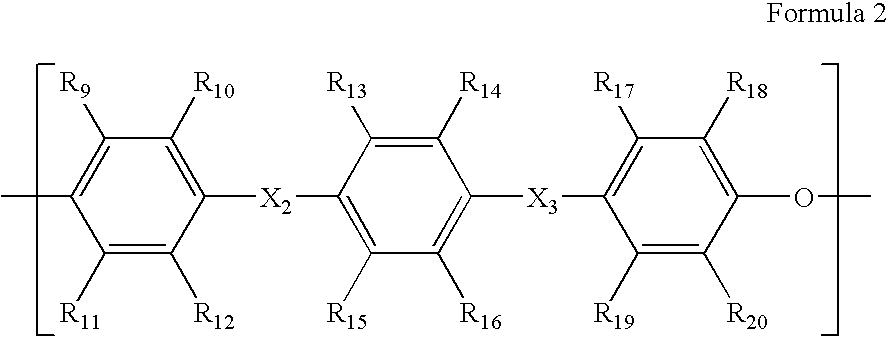Crosslinkable sulfonated copolymer and fuel cell including polymeric composition of the same
a crosslinking sulfonated copolymer and fuel cell technology, applied in the field of crosslinking sulfonated copolymer and fuel cell including a polymeric composition of the same, can solve the problems of electric potential drop and dmfc performance decline, and achieve excellent ionic conductivity and reduce methanol crossover
- Summary
- Abstract
- Description
- Claims
- Application Information
AI Technical Summary
Benefits of technology
Problems solved by technology
Method used
Image
Examples
example 1
[0064]
wherein, the mole ratio m / n=1 / 1.
[0065]As shown in Reaction Formula 1, 5.406 g (23.68 mmol) of diol compound of Formula 51, 2.583 g (11.84 mmol) of dihalide compound of Formula 52, 5.000 g (11.84 mmol) of dihalide compound containing sulfonic acid salt of Formula 53, and 4.25 g of anhydrous K2CO3 were injected into a 250 ml three-neck flask equipped with Dean-Stark trap. Then, 65 ml of dimethylsulfoxide and 30 ml of toluene were added to the 250 ml three-neck flask and mixed as a solvent.
[0066]The mixture was refluxed with nitrogen at 140° C. for 4 hours, and then water generated was removed. After removing water, toluene was removed. The reaction temperature was increased to 180° C., and at 180° C., polymerization was performed for 16 hours. Subsequently, 0.54 g (2.368 mmol) of diol compound of Formula 51 and 30 ml of toluene were added to the resultant and then a reflux reaction was additionally performed for 12 hours. Accordingly, a sulfonated copolymer of Formula 54 having ...
example 2
[0068]5 g of sulfonated copolymer of Formula 54 obtained from Example 1 was dissolved in 30 ml of dried 1-methyl-2-pyrrolidinone with nitrogen, and then 1.42 g of NaH (60% dispersion in mineral oil) was added thereto. The result was stirred for 6 hours at an ambient temperature, and then cooled down using ice water. Subsequently, 5.4 g of methacryloyl chloride was slowly added to the result. Then, the reaction was performed for 12 hours at the ambient temperature. The reaction precipitate was separated through a glass filter, and then the filtrate was precipitated into a mixed solution of methanol and water. Next, the resultant was dried under a vacuum to obtain a methacrylic end-capped crosslinkable sulfonated polyetheretherketone copolymer of Formula 55 above. The structure of the methacrylic end-capped crosslinkable sulfonated polyetheretherketone copolymer was analyzed using nuclear magnetic resonance, and a characteristic peak of the methacryl group was confirmed as below.
[0069...
examples 3 to 5
[0070]The crosslinkable sulfonated copolymer of Formula 54 obtained from Example 2 and a copolymer of any one of Formulas 61 or 62 were completely dissolved in dimethylsulfoxide shown in Table 1, and the resulting mixture was cast onto a glass plate. Accordingly, the result was dried in an oven at 60° C. for 12 hours to prepare a polymer electrolyte membrane. Next, the polymer electrolyte membrane was soaked in 1.5 M sulfuric acid solution for 24 hours for protonation. Subsequently, the product was immersed in distilled water for 24 hours to obtain polymer membranes having the thickness shown in Table 1 below.
wherein, m / n=4 / 1.
wherein, a / c=5 / 95 and b / d=33.3 / 66.6.
PUM
| Property | Measurement | Unit |
|---|---|---|
| Percent by mass | aaaaa | aaaaa |
| Percent by mass | aaaaa | aaaaa |
| Thickness | aaaaa | aaaaa |
Abstract
Description
Claims
Application Information
 Login to View More
Login to View More - R&D
- Intellectual Property
- Life Sciences
- Materials
- Tech Scout
- Unparalleled Data Quality
- Higher Quality Content
- 60% Fewer Hallucinations
Browse by: Latest US Patents, China's latest patents, Technical Efficacy Thesaurus, Application Domain, Technology Topic, Popular Technical Reports.
© 2025 PatSnap. All rights reserved.Legal|Privacy policy|Modern Slavery Act Transparency Statement|Sitemap|About US| Contact US: help@patsnap.com



